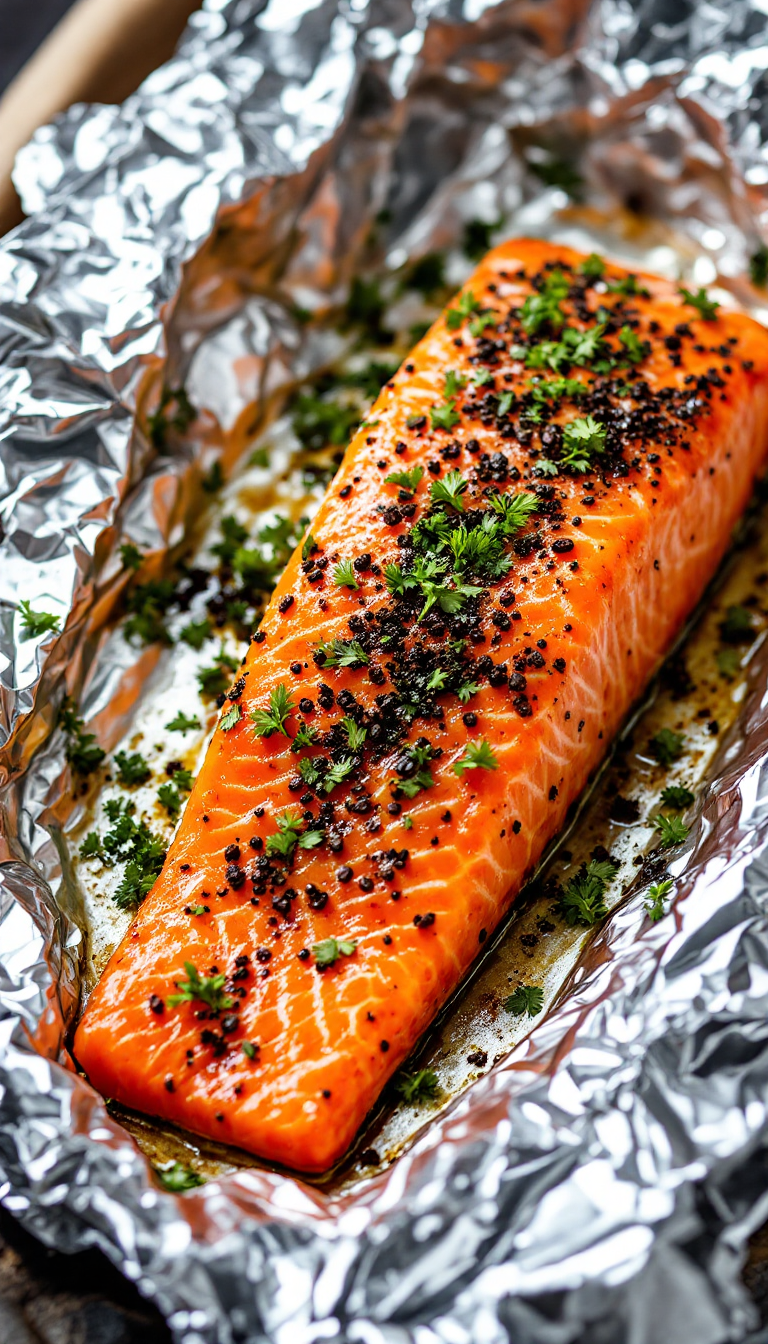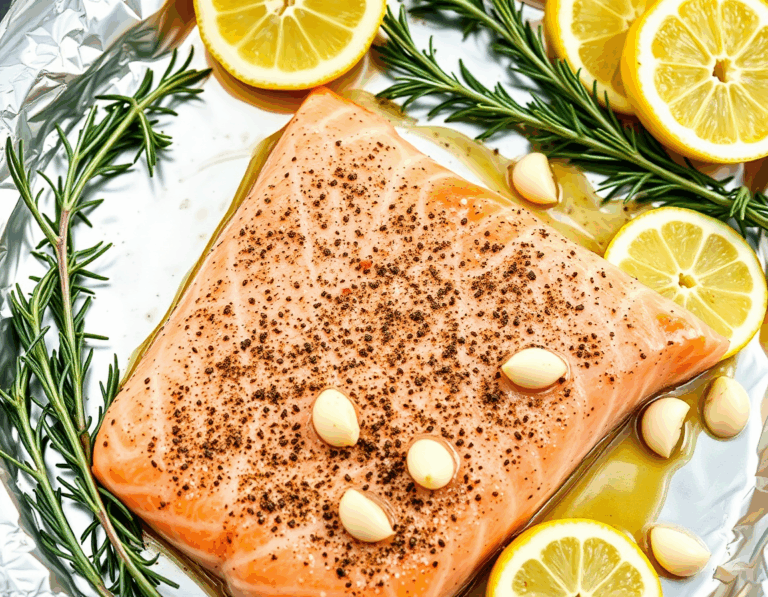
Salmon’s always been my go-to when I need to impress without really trying. It’s like that old reliable friend who’s never let you down—well, except that one time I overcooked it, but let’s not dwell on that. Wrapped in foil, bathed in garlic butter, this simple recipe transforms a fillet into pure magic, and with cleanup as a breeze, it’s a weeknight win.
Plus, did you hear about the latest trend in salmon skin chips? They’re all the rage!
Steps
- Allow the salmon to sit at room temperature for 10 minutes while preparing other ingredients. Preheat the oven to 375 degrees F, and line a large baking dish or sheet with aluminum foil, coating it lightly with baking spray.
- Arrange two rosemary sprigs and half of the lemon slices on the foil. Place the salmon on top and coat it with olive oil, salt, and pepper, then scatter garlic cloves over it.
- Add the remaining rosemary and lemon slices on top of the salmon, squeeze lemon juice over it, and fold the foil to form a sealed packet, leaving space for air circulation.
- Bake the salmon for 15-20 minutes until almost cooked through, adjusting time based on thickness. Then, open the foil to uncover the fish and broil for 3 minutes until slightly golden.
- Remove the salmon from the oven, check for doneness, and let it rest if needed. When it flakes easily with a fork, it’s ready to serve.
- Cut into portions, sprinkle with fresh herbs, and add a squeeze of lemon before serving. Enjoy the salmon the day it’s made for the best flavor and texture.

Ingredients
- 2 pound side of salmon, boneless (skin on or off), preferably wild caught
- 5 sprigs fresh rosemary or other fresh herbs of your choice (avoid dried herbs)
- 2 small lemons, divided, plus extra for serving if desired
- 2 tablespoons extra virgin olive oil
- 1 teaspoon kosher salt
- ¼ teaspoon ground black pepper
- 4 cloves garlic, peeled and roughly chopped
- Additional fresh herbs such as basil, thyme, parsley, dill, or green onion (optional)
Nutritional Values
Calories: 1080kcal | Carbohydrates: 24g | Protein: 168g | Fat: 36g | Saturated Fat: 6g | Cholesterol: 360mg | Fiber: 6g
FAQ
- Can I Eat Salmon Skin?
- Yes, salmon skin is edible and contains many of the same nutrients as the fish itself. However, when salmon is baked, the skin can become soft and rubbery, which may not be appetizing. If you prefer crispy skin, try preparing salmon by pan-searing or frying it instead.
- My Salmon is Still Pink! Is it Done?
- Salmon may remain pink even when fully cooked, especially in varieties like coho that are naturally deep pink. The key is to look for opacity and flakiness. If it’s translucent, it might not be done. Use an instant-read thermometer to check the temperature. It should reach 135 to 140 degrees F for medium rare/medium, and allow it to rest to reach the ideal temperature.
- Can I Freeze Baked Salmon?
- Yes, baked salmon can be frozen, but it may alter the texture and enhance the “fishy” taste. Freeze it in an airtight container for up to two months. Thaw overnight in the refrigerator, and use in recipes like Salmon Salad or Salmon Patties.
- What’s the Best Temperature for Baking Salmon?
- For individual fillet portions, a higher temperature of 400 to 425 degrees F works best. For a larger side of salmon, bake at 375 degrees F to ensure even cooking without drying out the fish.
- How Long to Bake Salmon?
- A large 2-pound side of salmon typically bakes for 15 to 20 minutes at 375 degrees F, while individual 6-ounce portions take about 12 to 14 minutes at 400 degrees F. Adjust based on thickness and size.
Tips
- Avoid Overcooking: Baking salmon in foil helps retain moisture, giving you a bit of leeway. However, remove it from the oven when it’s almost done at the thickest part to prevent overcooking. You can finish it under the broiler for a crispy top.
- Check for Doneness: Use a sharp knife to peek into the thickest part of the salmon. If it begins to flake but still has some translucency in the center, it’s ready. Alternatively, an instant-read thermometer should show 137-140°F when you take it out, as it will continue to cook as it rests.
- Experiment with Seasonings: While salt, pepper, and olive oil are sufficient, try adding fresh herbs like dill or parsley, or use lemon and butter for a richer flavor. Avoid dried herbs as they can detract from the fish’s freshness.
- Reheating Leftovers: If you have leftovers, reheat gently to avoid drying out. Bring the salmon to room temperature, then warm it in a skillet with a splash of water or in the microwave on low power.
Equipment
- Instant-read thermometer – Useful for checking the internal temperature of the salmon to ensure it’s cooked properly.
- Large baking dish or rimmed baking sheet – Essential for holding the salmon and foil packet while baking.
- Aluminum foil – Necessary for creating the foil packet to bake the salmon. (While many households have aluminum foil, if you don’t, you can find it easily online.)
